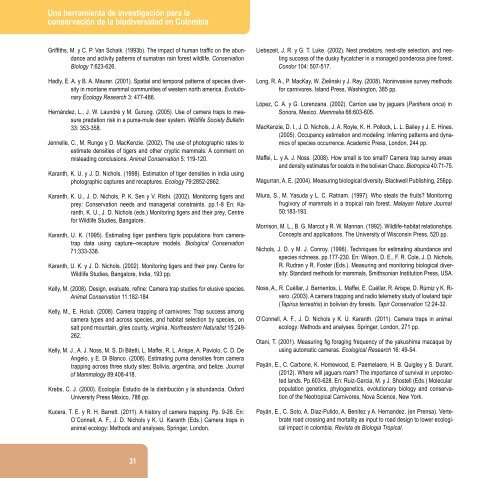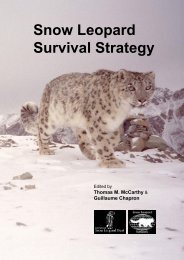Manual de fototrampeo - Panthera
Manual de fototrampeo - Panthera
Manual de fototrampeo - Panthera
You also want an ePaper? Increase the reach of your titles
YUMPU automatically turns print PDFs into web optimized ePapers that Google loves.
Una herramienta <strong>de</strong> investigación para la<br />
conservación <strong>de</strong> la biodiversidad en Colombia<br />
Griffiths, M. y C. P. Van Schaik. (1993b). The impact of human traffic on the abundance<br />
and activity patterns of sumatran rain forest wildlife. Conservation<br />
Biology 7:623-626.<br />
Hadly, E. A. y B. A. Maurer. (2001). Spatial and temporal patterns of species diversity<br />
in montane mammal communities of western north america. Evolutionary<br />
Ecology Research 3: 477-486.<br />
Hernán<strong>de</strong>z, L., J. W. Laundré y M. Gurung. (2005). Use of camera traps to measure<br />
predation risk in a puma-mule <strong>de</strong>er system. Wildlife Society Bulletin<br />
33: 353-358.<br />
Jennelle, C., M. Runge y D. MacKenzie. (2002). The use of photographic rates to<br />
estimate <strong>de</strong>nsities of tigers and other cryptic mammals: A comment on<br />
misleading conclusions. Animal Conservation 5: 119-120.<br />
Karanth, K. U. y J. D. Nichols. (1998). Estimation of tiger <strong>de</strong>nsities in india using<br />
photographic captures and recaptures. Ecology 79:2852-2862.<br />
Karanth, K. U., J. D. Nichols, P. K. Sen y V. Rishi. (2002). Monitoring tigers and<br />
prey: Conservation needs and managerial constraints. pp.1-8 En: Karanth,<br />
K. U., J. D. Nichols (eds.) Monitoring tigers and their prey, Centre<br />
for Wildlife Studies, Bangalore.<br />
Karanth, U. K. (1995). Estimating tiger panthera tigris populations from cameratrap<br />
data using capture--recapture mo<strong>de</strong>ls. Biological Conservation<br />
71:333-338.<br />
Karanth, U. K. y J. D. Nichols. (2002). Monitoring tigers and their prey. Centre for<br />
Wildlife Studies, Bangalore, India, 193 pp.<br />
Kelly, M. (2008). Design, evaluate, refine: Camera trap studies for elusive species.<br />
Animal Conservation 11:182-184<br />
Kelly, M., E. Holub. (2008). Camera trapping of carnivores: Trap success among<br />
camera types and across species, and habitat selection by species, on<br />
salt pond mountain, giles county, virginia. Northeastern Naturalist 15:249-<br />
262.<br />
Kelly, M. J., A. J. Noss, M. S. Di Bitetti, L. Maffei, R. L. Arispe, A. Paviolo, C. D. De<br />
Angelo, y E. Di Blanco. (2008). Estimating puma <strong>de</strong>nsities from camera<br />
trapping across three study sites: Bolivia, argentina, and belize. Journal<br />
of Mammalogy 89:408-418.<br />
Krebs, C. J. (2000). Ecología: Estudio <strong>de</strong> la distribución y la abundancia. Oxford<br />
University Press México, 786 pp.<br />
Kucera, T. E. y R. H. Barrett. (2011). A history of camera trapping. Pp. 9-26. En:<br />
O´Connell, A. F., J. D. Nichols y K. U. Karanth (Eds.) Camera traps in<br />
animal ecology: Methods and analyses, Springer, London.<br />
Liebezeit, J. R. y G. T. Luke. (2002). Nest predators, nest-site selection, and nesting<br />
success of the dusky flycatcher in a managed pon<strong>de</strong>rosa pine forest.<br />
Condor 104: 507-517.<br />
Long, R. A., P. MacKay, W. Zielinski y J. Ray. (2008). Noninvasive survey methods<br />
for carnivores. Island Press, Washington, 385 pp.<br />
López, C. A. y G. Lorenzana. (2002). Carrion use by jaguars (<strong>Panthera</strong> onca) in<br />
Sonora, Mexico. Mammalia 66:603-605.<br />
MacKenzie, D. I., J. D. Nichols, J. A. Royle, K. H. Pollock, L. L. Bailey y J. E. Hines.<br />
(2005). Occupancy estimation and mo<strong>de</strong>ling: Inferring patterns and dynamics<br />
of species occurrence. Aca<strong>de</strong>mic Press, London, 244 pp.<br />
Maffei, L. y A. J. Noss. (2008). How small is too small? Camera trap survey areas<br />
and <strong>de</strong>nsity estimates for ocelots in the bolivian Chaco. Biotropica 40:71-75.<br />
Magurran, A. E. (2004). Measuring biological diversity. Blackwell Publishing, 256pp.<br />
Miura, S., M. Yasuda y L. C. Ratnam. (1997). Who steals the fruits? Monitoring<br />
frugivory of mammals in a tropical rain forest. Malayan Nature Journal<br />
50:183-193.<br />
Morrison, M. L., B. G. Marcot y R. W. Mannan. (1992). Wildlife-habitat relationships.<br />
Concepts and applications. The University of Wisconsin Press, 520 pp.<br />
Nichols, J. D. y M. J. Conroy. (1996). Techniques for estimating abundance and<br />
species richness. pp.177-230. En: Wilson, D. E., F. R. Cole, J. D. Nichols,<br />
R. Rudran y R. Foster (Eds.). Measuring and monitoring biological diversity:<br />
Standard methods for mammals, Smithsonian Institution Press, USA.<br />
Noss, A., R. Cuéllar, J. Barrientos, L. Maffei, E. Cuéllar, R. Arispe, D. Rúmiz y K. Rivero.<br />
(2003). A camera trapping and radio telemetry study of lowland tapir<br />
(Tapirus terrestris) in bolivian dry forests. Tapir Conservation 12:24-32.<br />
O’Connell, A. F., J. D. Nichols y K. U. Karanth. (2011). Camera traps in animal<br />
ecology: Methods and analyses. Springer, London, 271 pp.<br />
Otani, T. (2001). Measuring fig foraging frequency of the yakushima macaque by<br />
using automatic cameras. Ecological Research 16: 49-54.<br />
Payán, E., C. Carbone, K. Homewood, E. Paemelaere, H. B. Quigley y S. Durant.<br />
(2012). Where will jaguars roam? The importance of survival in unprotected<br />
lands. Pp.603-628. En: Ruiz-Garcia, M. y J. Shostell (Eds.) Molecular<br />
population genetics, phylogenetics, evolutionary biology and conservation<br />
of the Neotropical Carnivores, Nova Science, New York.<br />
Payán, E., C. Soto, A. Diaz-Pulido, A. Benitez y A. Hernan<strong>de</strong>z. (en Prensa). Vertebrate<br />
road crossing and mortality as input to road <strong>de</strong>sign to lower ecological<br />
impact in colombia. Revista <strong>de</strong> Biologia Tropical.<br />
31

















